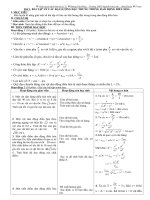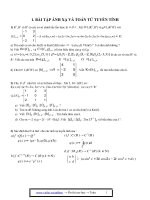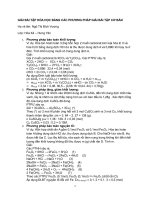Bai Tap Java cơ bản
Bạn đang xem bản rút gọn của tài liệu. Xem và tải ngay bản đầy đủ của tài liệu tại đây (118.01 KB, 16 trang )
Chuong1:
1. Giải phương trình bậc nhất : ax+b=0
2. Phương trình bậc hai : ax2 + bx + c=0
3. Tìm số trung gian của 3 số a,b,c
4. Viết chương trình tính tiền cho bài toán KaraOke
+ Giờ bắt đầu : a (int)
+ Giờ kết thúc : b (int)
+ Nếu nhỏ hơn 18h : 45000đ/1h, lớn hơn 18h : 60000đ/1h
5. Nhập vào tháng, năm bất kỳ. In ra số ngày tương ứng với tháng, năm đó.
Cấu trúc lặp :
6. Viết chương trình tính :
S=1+1/2+1/3+....+1/n
class myclass
{
public void tinhS(int x)
{
int S=0;
for(int i=1;i<=x;i++)
S+=1/x;
System.out.println(“S = “+S);
}
public static void main(string [] args)
{
myclass dt=new myclass();
dt.tinhS(20);
}
}
7. Viết chương trình tính :
S=15-1+1/2-1/3!+....+(-1)n 1/n!
class myclass
{
public tinhS(int n)
{
int S=15, a=1;
for(int i=1;i
if(i%2==0) x=1;
else x=-1;
a*=i;
S+=x/a;
}
System.out.println(“S= “+S);
}
public static void main(string [] args)
{
myclass dt=new myclass();
dt.tinhS(20);
}
}
8. Viết chương trình tính :
S=1+1/3!+1/5!+…..+1/(2n-1)!
class myclass
{
public void tinhS(int n)
{
int S=1, a=1;
for(int i=1;i<2n;i+2)
{
S+=1/a;
a*=i*(i+1);
}
System.out.println(“S = “+S);
}
public static void main(string [] args)
{
myclass dt = new myclass();
dt,tinhS(29);
}
}
9. Tính n!! = 1*3*5*…..*n(n lẽ)
= 2*4*6*….*n(n chẵn)
class myclass
{
public tinhN(int n)
{
int N;
for(int i= n%2+2;i<=n;i+=2)
N*=i;
System.out.println(“N!!=”+N);
}
public static void main(string [] args)
{
myclass dt=new myclass();
dt.tinhN(0);
}
}
10. Tính tổng và tích các chữ số của một số nguyên dương m cho trước
(Ví dụ : m=234=> S=2+3+4=9, P=2*3*4=24)
class myclass
{
public void tongvatich(int n)
{
int S, P;
do
{
S+=n%10;
P*=n%10;
n/=10;
}while(n!=0);
System.out.println(“\nTong S=”+S+”\nTich P=”+P);
}
public static void main(string [] args)
{
myclass dt= new myclass();
dt.tongvatich(294);
}
}
11. Nhập một số và kiểm tra có phải nguyên tố không?
12. Kiểm tra số P có phải là số chính phương không?
13. Kiểm tra số M có phải là số đối xứng không?
public class myclass1
{
public void doixung(int so)
{
int x,y,i=0,n,a=0;
x=y=n=so;
String s="";
while(so>0)
{
i++;
so/=10;
}
if(i%2==1)a=1;
for(int j=1;j<=i/2+a;j++)
{
x=x/10;
}
for(int j=1;j<=i/2;j++)
{
s+=y%10;
y/=10;
}
if(x==Integer.parseInt(s))
System.out.println("So "+n+" la so doi xung");
else
System.out.println("So "+n+" la so khong doi xung");
}
public static void main(String s[])
{
myclass1 dt=new myclass1();
dt.doixung(123321);
}
}
14. In ra các số nguyên tố nhỏ hơn hoặc bằng số nguyên dương n cho trước
public class songuyento
{
public boolean nguyento(int n)
{
if(n<2)return false;
if(n==2)return true;
for(int i=2;i<=Math.sqrt(n);i++)
{
if(n%i==0)return false;
}return true;
}
public static void main(String s[])
{
songuyento dt=new songuyento();
for(int i=1;i<=92;i++)
if(dt.nguyento(i))
System.out.println(i);
}
}
15. In ra các số hoàn hảo nhỏ hơn 1000
( Ví dụ : 6=1+2+3, 28=1+2+4+7+14)
public class Sohoanhao {
public boolean shh(int n)
{
int sum=0;
for(int i=1;sum<=n&&i
{
if(n%i==0)sum+=i;
if(sum==n)return true;
}return false;
}
public static void main(String args[])
{
Sohoanhao dt=new Sohoanhao();
for(int i=1;i<1000;i++)
{
if(dt.shh(i))
System.out.println(i);
}
}
}
16. In ra n chữ số Fibonaci đầu tiên
public class Fibonaci {
public int Fibonaci(int n)
{
if(n==1||n==2)return 1;
else return Fibonaci(n-1)+Fibonaci(n-2);
}
public static void main(String s[])
{
Fibonaci dt=new Fibonaci();
for(int i=1;i<=20;i++)
{
System.out.println(dt.Fibonaci(i));
}
}
}
17. Kiểm tra số K có thuộc dãy Fibonaci hay không?
import java.util.*;
public class kiemtraFibonaci {
public int Fibonaci(int n)
{
if(n==1||n==2)return 1;
return Fibonaci(n-1)+Fibonaci(n-2);
}
public static void main(String args[])
{
kiemtraFibonaci dt=new kiemtraFibonaci();
int s=1,K;
Scanner x=new Scanner(System.in);
System.out.println("Nhập K:");
K=x.nextInt();
while(true)
{
if(K==dt.Fibonaci(s))
{
System.out.println(K+" thuộc Fibonaci");
break;
}
if(K
System.out.println(K+" không thuộc dãy Fibonaci");
break;
}
s++;
}
}
}
18. Tìm ước chung lớn nhất và bội chung nhỏ nhất của 2 số a và b
import java.util.*;
public class UCLN {
public int UCLN(int x,int y)
{
if(x==0||y==0)return 0;
if(x==y)return x;
if(x>y)return UCLN(x-y,y);
return UCLN(x,y-x);
}
public static void main(String args[])
{
UCLN dt=new UCLN();
Scanner x= new Scanner(System.in);
int a,b;
System.out.println("Nhập a: ");
a=x.nextInt();
System.out.println("Nhập b: ");
b=x.nextInt();
System.out.println("Ước Chung lớn nhất : "+dt.UCLN(a,b));
System.out.println("Bội Chung nhỏ nhất : "+a*b/dt.UCLN(a, b));
}
}
4.1 .Giải phưong trình bậc nhất :
import java.awt.*;
import java.awt.event.*;
public class Giaiptbn extends Frame implements ActionListener
{
Label giai, nhapa, nhapb,inkq;
TextField a,b,kq;
Button tinh,reset,thoat;
Panel pn,pn1,pn2,pn3,pn4,pn5;
public void GUI()
{
giai=new Label("Giải Phương Trình Bậc Nhất ax+b=0");
nhapa=new Label("Nhập a");
nhapb=new Label("Nhập b");
inkq=new Label("Kết quả");
a=new TextField("");
b=new TextField("");
kq=new TextField("");
tinh=new Button("Tính");
reset=new Button("Reset");
thoat=new Button("Thoát");
tinh.addActionListener(this);
reset.addActionListener(this);
thoat.addActionListener(this);
pn=new Panel(new GridLayout(5,1));
pn1=new Panel(new FlowLayout());
pn2=new Panel(new GridLayout(1,2));
pn3=new Panel(new GridLayout(1,2));
pn4=new Panel(new GridLayout(1,2));
pn5=new Panel(new GridLayout(1,3));
pn1.add(giai);
pn2.add(nhapa);
pn2.add(a);
pn3.add(nhapb);
pn3.add(b);
pn4.add(inkq);
pn4.add(kq);
pn5.add(tinh);
pn5.add(reset);
pn5.add(thoat);
pn.add(pn1);
pn.add(pn2);
pn.add(pn3);
pn.add(pn4);
pn.add(pn5);
add(pn);
setSize(300,200);
setVisible(true);
}
public void actionPerformed(ActionEvent e)
{
if(e.getSource()==tinh)
{
int x=Integer.parseInt(a.getText());
int y=Integer.parseInt(b.getText());
if(x==0) kq.setText("Phương trình vô nghiệm");
else
{
if(y==0) kq.setText("Phương trình có vô số nghiệm");
else kq.setText(Float.toString((float)-y/x));
}
}
if(e.getSource()==reset)
{
a.setText(" ");
b.setText(" ");
kq.setText(" ");
}
if(e.getSource()==thoat)
{
System.exit(0);
}
}
public Giaiptbn(String st)
{
super(st);
GUI();
}
public static void main(String [] args)
{
new Giaiptbn("GIẢI PHƯƠNG TRÌNH BẬC NHẤT AX+B=0");
}
}
4.2 Minh họa các phép toán :
import java.awt.*;
import java.awt.event.*;
public class Cacpheptoan extends Frame implements ActionListener
{
Label pheptoan,nhapa,nhapb,inkq;
TextField a,b,kq;
Button cong,tru,nhan,chia,thoat,reset,ketqua;
Panel pn,pn1,pn2,pn3,pn4,pn5,pn6;
public void GUI()
{
pheptoan=new Label("Các phép toán");
nhapa=new Label("Nhập a");
nhapb=new Label("Nhập b");
inkq=new Label("Kết quả");
a=new TextField("");
b=new TextField("");
kq=new TextField("");
cong=new Button("Cộng");
tru=new Button("Trừ");
nhan=new Button("Nhân");
chia=new Button("Chia");
reset=new Button("Reset");
thoat=new Button("Exit");
cong.addActionListener(this);
tru.addActionListener(this);
nhan.addActionListener(this);
chia.addActionListener(this);
reset.addActionListener(this);
thoat.addActionListener(this);
pn=new Panel(new GridLayout(6,1));
pn1=new Panel(new GridLayout(1,2));
pn2=new Panel(new GridLayout(1,2));
pn3=new Panel(new GridLayout(1,2));
pn4=new Panel(new GridLayout(1,2));
pn5=new Panel(new FlowLayout());
pn6=new Panel(new FlowLayout());
pn1.add(pheptoan);
pn2.add(nhapa);
pn2.add(a);
pn3.add(nhapb);
pn3.add(b);
pn4.add(inkq);
pn4.add(kq);
pn5.add(cong);
pn5.add(tru);
pn5.add(nhan);
pn5.add(chia);
pn6.add(thoat);
pn6.add(reset);
pn.add(pn1);
pn.add(pn2);
pn.add(pn3);
pn.add(pn4);
pn.add(pn5);
pn.add(pn6);
add(pn);
setSize(500,300);
setVisible(true);
}
public void actionPerformed(ActionEvent e)
{
int x=Integer.parseInt(a.getText());
int y=Integer.parseInt(b.getText());
if(e.getSource()==thoat)
{
System.exit(0);
}
if(e.getSource()==cong)
{
kq.setText(Float.toString((float)x+y));
}
if(e.getSource()==tru)
{
kq.setText(Float.toString((float)x-y));
}
if(e.getSource()==nhan)
{
kq.setText(Float.toString((float)x*y));
}
if(e.getSource()==chia)
{
if(y==0)kq.setText("Vô nghiệm");
else kq.setText(Float.toString((float)x/y));
}
if(e.getSource()==reset)
{
a.setText(" ");
b.setText(" ");
kq.setText(" ");
}
}
public Cacpheptoan(String st)
{
super(st);
GUI();
}
public static void main(String [] args)
{
new Cacpheptoan("Các PHÉP TOÁN");
}
}
4.3 In các số nguyên tố nhỏ hơn hoặc bằng số n cho trước :
import java.awt.*;
import java.awt.event.*;
public class Songuyento extends Frame implements ActionListener
{
Label lb,nhapn,kq;
TextField n,kqua;
Button tim,reset,thoat;
Panel pn,pn1,pn2,pn3,pn4;
public void GUI()
{
lb=new Label("Các số nguyên tố <=n");
nhapn=new Label("Nhập n");
kq=new Label("Kết quả");
n=new TextField("");
kqua=new TextField("");
tim=new Button("Tìm");
reset=new Button("Reset");
thoat=new Button("Exit");
tim.addActionListener(this);
reset.addActionListener(this);
thoat.addActionListener(this);
pn=new Panel(new GridLayout(4,1));
pn1=new Panel(new FlowLayout());
pn2=new Panel(new GridLayout(1,2));
pn3=new Panel(new GridLayout(1,2));
pn4=new Panel(new FlowLayout());
pn1.add(lb);
pn2.add(nhapn);
pn2.add(n);
pn3.add(kq);
pn3.add(kqua);
pn4.add(tim);
pn4.add(reset);
pn4.add(thoat);
pn.add(pn1);
pn.add(pn2);
pn.add(pn3);
pn.add(pn4);
add(pn);
setSize(500,300);
setVisible(true);
}
private int songuyento(int a)
{
for(int i=2;i<=Math.sqrt(a);i++)
{
if(a%i==0) return 0;
}
return 1;
}
public void actionPerformed(ActionEvent e)
{
String s="";
int x=Integer.parseInt(n.getText());
if(e.getSource()==thoat)
{
System.exit(0);
}
if(e.getSource()==tim)
{
if(x<2)kqua.setText("Không có số nguyên tố nào");
else
{
for(int i=2;i<=x;i++)
{
if(songuyento(i)==1) s+=Integer.toString((int)i)+" ";
}
kqua.setText(s);
}
}
if(e.getSource()==reset)
{
n.setText("");
kqua.setText("");
}
}
public Songuyento(String st)
{
super(st);
GUI();
}
public static void main(String []args)
{
new Songuyento("SỐ NGUYÊN TỐ");
}
}
4.4Kiểm tra một số có thuộc dãy Fibonaci hay không?
import java.awt.*;
import java.awt.event.*;
public class Fibonaci extends Frame implements ActionListener
{
Label lb,nhapa,kqua;
TextField a,kq;
Button ok,reset,thoat;
Panel pn,pn1,pn2,pn3,pn4;
public void GUI()
{
lb=new Label("Kiểm tra a có thuộc dãy Fibonaci");
nhapa=new Label("Nhập a");
kqua=new Label("Kết quả");
a=new TextField("",20);
kq=new TextField("",20);
ok=new Button("OK");
reset=new Button("Reset");
thoat=new Button("Exit");
ok.addActionListener(this);
reset.addActionListener(this);
thoat.addActionListener(this);
pn=new Panel(new GridLayout(4,1));
pn1=new Panel(new FlowLayout());
pn2=new Panel(new FlowLayout());
pn3=new Panel(new FlowLayout());
pn4=new Panel(new FlowLayout());
pn1.add(lb);
pn2.add(nhapa);
pn2.add(a);
pn3.add(kqua);
pn3.add(kq);
pn4.add(ok);
pn4.add(reset);
pn4.add(thoat);
pn.add(pn1);
pn.add(pn2);
pn.add(pn3);
pn.add(pn4);
add(pn);
setSize(500,300);
setVisible(true);
}
public void actionPerformed(ActionEvent e)
{
int n=Integer.parseInt(a.getText());
if(e.getSource()==thoat)
{
System.exit(0);
}
if(e.getSource()==reset)
{
a.setText("");
kq.setText("");
}
if(e.getSource()==ok)
{
if(n<1)kq.setText(n+" không thuộc dãy Fibonaci");
else
{
int f,i=1;
do
{
f=fibonaci(i);
if(n==f)
{
kq.setText(n+" thuộc dãy Fibonaci");
break;
}
if(n
kq.setText(n+" không thuộc dãy Fibonaci");
break;
}
i++;
}while(true);
}
}
}
private int fibonaci(int x)
{
if(x==1||x==2) return 1;
else return fibonaci(x-1)+fibonaci(x-2);
}
public Fibonaci(String st)
{
super(st);
GUI();
}
public static void main(String []args)
{
new Fibonaci("Fibonaci");
}
}
4.5Mô tả máy tính điên tử cá nhân
4.6Đổi màu nền :
‘BaiTap Mang A[n]
import java.util.*;
public class mangA
{
public int tong(int m[],int n)
{
int sum=0;
for(int i=0;i
if(m[i]%2==1)sum+=m[i];
}return sum;
}
public void timK(int m[],int n,int k)
{
for(int i=0;i
if(m[i]==k)
{
System.out.println("Vi tri cua "+k+" la: "+(i+1));
break;
}
}
}
public void sapxep(int m[],int n)
{
int tam;
for(int i=0;i
{
tam=m[i];
m[i]=m[j];
m[j]=tam;
}
System.out.println("Mang A[]");
for(int i=0;i
}
public void chen(int m[], int n,int p)
{
m[n]=p;n++;
sapxep(m,n);
}
public static void main(String args[])
{
mangA dt=new mangA();
Scanner x=new Scanner(System.in);
int n,A[]=new int[100],k,p;
System.out.println("Nhap chiu dai mang: n = ");
n=x.nextInt();
for(int i=0;i
System.out.println("A["+(i+1)+"] = ");
A[i]=x.nextInt();
}
System.out.println("Tong cac so le trong mang = "+dt.tong(A,n));
System.out.println("Nhap so can tim: ");
k=x.nextInt();
dt.timK(A, n, k);
dt.sapxep(A, n);
System.out.println("Nhap so can chen: ");
p=x.nextInt();
dt.chen(A, n, p);
}
}
Mang B[m][n]
import java.util.*;
public class mangB
{
static int B[][]=new int[100][100],X[]=new int[100],n,m;
public void tich()
{
int t=1;
for(int i=0;i
if(B[0][i]%3==0)t*=B[0][i];
}
if(t==1)System.out.println("Khong co so bo ba nao");
else System.out.println("Tich cac so bo ba: "+t);
}
public void mang1chieu()
{
for(int i=0;i
for(int i=0;i
if(X[i]
}
for(int i=0;i
System.out.println("X["+(i+1)+"] = "+X[i]);
}
public void xoasole()
{
for(int i=0;i
{
n--;
for(int j=i;j
break;
}
for(int i=0;i
}
public void sapxep()
{
int tam;
for(int i=0;i
if(X[i]
tam=X[i];
X[i]=X[j];
X[j]=tam;
}
}
for(int i=0;i
}
public static void main(String args[])
{
mangB dt= new mangB();
Scanner y=new Scanner(System.in);
System.out.println("Nhap m,n: ");
m=y.nextInt();
n=y.nextInt();
System.out.println("Nhap mang B[][]");
for(int i=0;i
System.out.println("B["+(i+1)+"]["+(j+1)+"] = ");
B[i][j]=y.nextInt();
}
dt.tich();
dt.mang1chieu();
dt.xoasole();
dt.sapxep();
}
}









